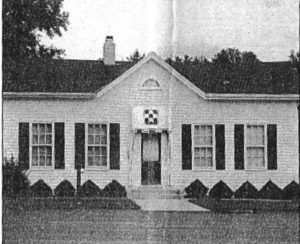By Regina Villiers. Originally published October 14, 1992 in The Suburban Life, added October 14, 2016.

The Case home as it looks today.

The old Case home on Camargo Road in Madeira as it looked in the 1940’s.
In its time, the old Case house on Camargo Road has resounded with many shouts and cries of children.
Said to be the oldest house in Madeira, the house was first built as a one-room schoolhouse 179 years ago in Allendale, a community that no longer exists. Allendale was located in the Blome Road-Terrace Park area.
Just when the old house was moved to its present Madeira location and became a dwelling has not been recorded, and there is some controversy as to its being Madeira’s oldest home.
But when Herbert and Mary (Molly) Case bought the house from Jim DeMar in 1933 and moved their family there, the house was said to already be 130 years old.
Harriet Case Parker, who grew up in the house, remembers vividly every detail about it. At the time the Cases moved into it, the house was much smaller. Her father, a plasterer, added on to the house in the early 1940’s making a new kitchen, dining room and bathroom.
When they first bought the house, there was no bathroom, Harriet said. It came equipped with an outhouse, a barn and a chicken house. Both a cistern and a working well were located by the right front corner of the house.
The lot was huge. The Cases grew a big garden, and the neighborhood ball field was in the back yard. So the four Case children, two boys and two girls never lacked playmates.
The house sat far back from the road and was shaded by immense maple trees, both in front and in back. “The house was always cool,” Harriet said.
There is a basement underneath the original schoolhouse section of the house, which is the front.
In the beginning, the basement was just a cellar with its entrance and steps on the outside of the house by the cistern. “But my father changed it,” Harriet said, “ and made the steps go down from the inside.”
There was no concrete between the stones in the foundation – just large stones fitted together.
There had been three fireplaces in the house. Two were still working when the Cases moved there, and the remnants of a third fireplace remained in the kitchen.
The beams in the attic still have bark on them, and there is a foot’s space between the thick walls. Harriet’s husband, Allen Parker, remembers helping his father-in-law remodel the bathroom in 1948-49.
“When we tore out the medicine cabinet,” he said, “there was rough-hewn oak lumber in there, two inches thick.”
It was discovered that there are ages of plaster in the house.
The house had a transom over the front door, and a half-round window in the attic, which still remains. The glass panes in the windows of the house are old, distorted glass.
The Cases sold off a lot from the property, on the right, in 1949, but the remaining land around the house today is still expansive, making the house seem most private and solitary as it sits there.
Herbert Case died in 1951, but Mary Case continued to live in the house until a few years ago when she sold it.
Now 90, Mrs. Case still lives in Madeira and she’s still active. This past June she took a 12-day trip to her native Scotland to visit cousins. The trip was a birthday gift from her children.
Mrs. Case first came to the United States when she was 6 years old. She went back to Scotland when she was 10, staying for four years. She then returned to this country where she has lived ever since.
After the Case family moved from the old house, it became a business location and a blacktopped parking space was put in front of the house near the street, taking up a part of the front yard. Until recently, the house had been occupied for a time, by an interior decorator, Wellingon House Interiors.
It stands there now as a sturdy reminder of Madeira’s past.
On a recent hazy day in September, it was easy to stroll the grounds of the old building and almost hear the distant shouts and murmurs of children – voices of schoolchildren past, blending with the voices of the Case youngsters.